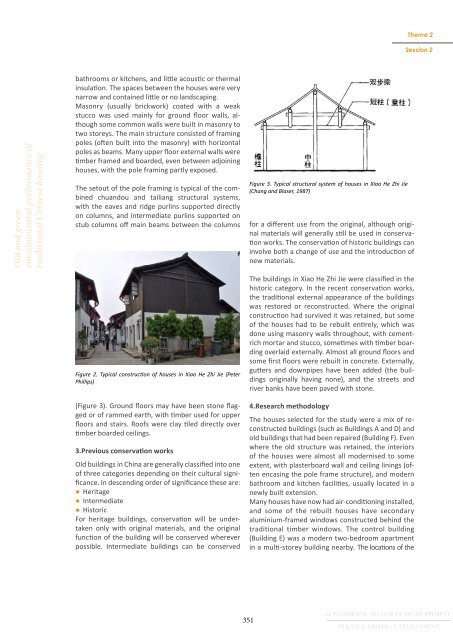PARTIE 2 - Icomos
PARTIE 2 - Icomos
PARTIE 2 - Icomos
Create successful ePaper yourself
Turn your PDF publications into a flip-book with our unique Google optimized e-Paper software.
Theme 2<br />
Session 2<br />
Old and green:<br />
environmental performance of<br />
traditional Chinese housing<br />
bathrooms or kitchens, and little acoustic or thermal<br />
insulation. The spaces between the houses were very<br />
narrow and contained little or no landscaping.<br />
Masonry (usually brickwork) coated with a weak<br />
stucco was used mainly for ground floor walls, although<br />
some common walls were built in masonry to<br />
two storeys. The main structure consisted of framing<br />
poles (often built into the masonry) with horizontal<br />
poles as beams. Many upper floor external walls were<br />
timber framed and boarded, even between adjoining<br />
houses, with the pole framing partly exposed.<br />
The setout of the pole framing is typical of the combined<br />
chuandou and tailiang structural systems,<br />
with the eaves and ridge purlins supported directly<br />
on columns, and intermediate purlins supported on<br />
stub columns off main beams between the columns<br />
Figure 3. Typical structural system of houses in Xiao He Zhi Jie<br />
(Chang and Blaser, 1987)<br />
for a different use from the original, although original<br />
materials will generally still be used in conservation<br />
works. The conservation of historic buildings can<br />
involve both a change of use and the introduction of<br />
new materials.<br />
Figure 2. Typical construction of houses in Xiao He Zhi Jie (Peter<br />
Phillips)<br />
(Figure 3). Ground floors may have been stone flagged<br />
or of rammed earth, with timber used for upper<br />
floors and stairs. Roofs were clay tiled directly over<br />
timber boarded ceilings.<br />
3.Previous conservation works<br />
Old buildings in China are generally classified into one<br />
of three categories depending on their cultural significance.<br />
In descending order of significance these are:<br />
●●<br />
Heritage<br />
●●<br />
Intermediate<br />
●●<br />
Historic<br />
For heritage buildings, conservation will be undertaken<br />
only with original materials, and the original<br />
function of the building will be conserved wherever<br />
possible. Intermediate buildings can be conserved<br />
The buildings in Xiao He Zhi Jie were classified in the<br />
historic category. In the recent conservation works,<br />
the traditional external appearance of the buildings<br />
was restored or reconstructed. Where the original<br />
construction had survived it was retained, but some<br />
of the houses had to be rebuilt entirely, which was<br />
done using masonry walls throughout, with cementrich<br />
mortar and stucco, sometimes with timber boarding<br />
overlaid externally. Almost all ground floors and<br />
some first floors were rebuilt in concrete. Externally,<br />
gutters and downpipes have been added (the buildings<br />
originally having none), and the streets and<br />
river banks have been paved with stone.<br />
4.Research methodology<br />
The houses selected for the study were a mix of reconstructed<br />
buildings (such as Buildings A and D) and<br />
old buildings that had been repaired (Building F). Even<br />
where the old structure was retained, the interiors<br />
of the houses were almost all modernised to some<br />
extent, with plasterboard wall and ceiling linings (often<br />
encasing the pole frame structure), and modern<br />
bathroom and kitchen facilities, usually located in a<br />
newly built extension.<br />
Many houses have now had air-conditioning installed,<br />
and some of the rebuilt houses have secondary<br />
aluminium-framed windows constructed behind the<br />
traditional timber windows. The control building<br />
(Building E) was a modern two-bedroom apartment<br />
in a multi-storey building nearby. The locations of the<br />
351<br />
LE PATRIMOINE, MOTEUR DE DÉVELOPPEMENT<br />
HERITAGE, DRIVER OF DEVELOPMENT

















